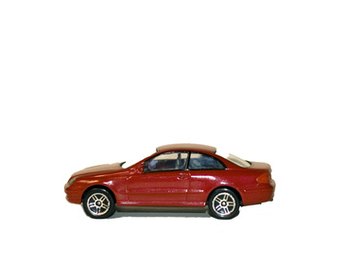
Toy cars aren't just fun to play with. They're perfect vehicles for a wide variety of science experiments, which can tell you a lot about things like energy, inertia, momentum, friction and vectors. Each experiment will require tools in addition to the toy cars, but there's a huge amount you can learn—and then you can go back to racing. These experiments are scientific, which means they involve measuring times, distances, weights and other variables.
Potential and Kinetic Energy
Set up a basic ramp against a chair, on top of some books, or from a table to the floor. Hold the car at the top of the ramp, and release to demonstrate the two main kinds of energy. Potential energy is placed into the car when it's lifted from the floor, and that energy is released as the car rolls down the ramp. Ramps should be made of a solid, smooth and rigid material such as wood or plywood.
Friction
Using the ramp from earlier, you can make a more interesting experiment by placing some things at the bottom. Drop the car from the top of the ramp again, and measure how far it rolls this time. Now, place a sheet of card stock at the bottom of the ramp, and let the car roll over that. Measure the distance it rolls. Place some sandpaper on top of the card stock, release the car, and measure that distance. Finally, try it with some carpet at the bottom. You've now learned something about friction: the card stock has a lot less friction than the carpet, so the car should be able to roll farther.
Inertia
Place a heavy stack of books a few feet from the end of the ramp, so that the car hits those books when it rolls from the top down. Demonstrate that once or twice, and then take a small ball of clay or putty. Place it on top of the car and pat it down slightly; don't squish it onto the car, but press it just enough so that it won't roll off. Roll the car down the ramp, and when it hits the books, the clay should fly off the front of the car. This happens because of Newton's first law of motion: anything moving is going to want to keep moving (until it crashes into a wall).
Car Racing
Take—or make—two cars and set them at the top of the ramp to race. Place a line of masking tape on the floor a few feet from the ramp, so it acts as a finish line. Release them and see which one goes the farthest and the fastest (using a measuring stick and a stopwatch). Now, try to make each car faster: place card stock along one track, or press clay onto the top of one car to weight it down. In order to properly scientifically test these, change only one thing at a time, but use the same measuring tools for all of them.
Vectors
Motion may seem like it's a one-way street, but more advanced science gets into things called vectors, which are used to plot a direction on a chart. To demonstrate one, place a piece of newspaper, plastic, or cardboard on the table (you may need to make a rope handle so you can pull it easily without wrinkling it). Roll a car slowly across the plastic, then start pulling the sheet out from under it. The car's forward motion combined with your pulling should make the car move diagonally—along a combined vector of both.
Mousetrap Cars
Building a science experiment from scratch makes it even more exciting. Begin with a simple, homemade toy car with an exposed rear axle. Make it a mousetrap racer by attaching a basic mousetrap as the motor, connected to a string on an axle. As the trap releases, the car is pulled forward. This shows lot of interesting physics. You can increase the traction—increase wheel friction—to make the car slip less. The mousetrap snapper arm is a perfect demonstration of torque, and you can get into rotational inertia with different types of wheels. Plus, racing different designs always ends in some interesting competitions. See Resources for more detailed information about mousetrap racers.
References
About the Author
Grahame Turner has worked as a freelance writer since 2009 and a freelance reporter since 2010 for Wellesley Patch and Jamaica Plain Patch in Massachusetts. He also works part-time as a bookseller at the Northeastern University bookstore. He is a Northeastern University graduate with a Bachelor of Arts in English.
Photo Credits
red car toy image by Dubravko Grakalic from Fotolia.com
